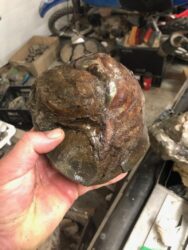Fossil hunter discovers rare sea mollusk
By Tim Kalinowski on February 9, 2021.
 Submitted photo
A close-up shot of the Nautiloid fossil (top half above the thumb). Like its cousin species ammonites, the fossilized shell has some iridescent qualities when held up to the light, and is closely related to the sea mollusk known as a Nautilus today.
Submitted photo
A close-up shot of the Nautiloid fossil (top half above the thumb). Like its cousin species ammonites, the fossilized shell has some iridescent qualities when held up to the light, and is closely related to the sea mollusk known as a Nautilus today.LETHBRIDGE HERALDtkalinowski@lethbridgeherald.com
An amateur fossil hunter with a knack for uncovering rare finds has done it again not far from Lethbridge.
Saskatchewan resident Jonathan Ganshorn, founder of the kids fossil hunting group the Dino Hunter Gang, discovered a rare sea fossil while out searching near the St. Mary River on Crown lands 20 km southwest of the city early last week.
Called a Nautiloid, the creature is a type of sea mollusk distantly related to its far more famous cousin the ammonites. This particular Nautiloid fossil dates to about the end of the dinosaur era 70 million years ago, but is far more rare, confirms Royal Tyrrell Museum curator of dinosaurs Donald Henderson.
“I checked out our (museum) catalogues,” says Henderson. “We have got hundreds and hundreds of ammonites from the Bearpaw formation of Alberta. We only have four Nautiloids. The Nautiloids were super-abundant about 300-400 million years ago, but over that time they became rarer and rarer. So there were not very many kinds left at the end of Cretaceous. But surprisingly, while the ammonites went extinct, the Nautiloids didn’t. The Nautiloids kept going, and we have still got some (living species) today.”
Henderson confirms the size of Ganshorn’s specimen, at a little over softball-sized, appears to be larger than any other one found in Alberta he is aware of, and also that fact it still retains its three dimensional shape adds to the rarity of the find.
“This one had exceptional preservation conditions as that body chamber filled up with mud and it solidified,” Henderson states. “Its shell was never crushed flat by the pressure of the overlying rocks.”
Despite its rarity, this actually isn’t the first Nautiloid fossil Ganshorn has discovered. He and his young daughter Lily found another one at Lake Diefenbaker in 2018, (only the third ever found in Saskatchewan and the first one found since 1963), and donated it to the Royal Saskatchewan Museum.
“You look for what is called a concretion,” Ganshorn explains. “We call them dinosaur eggs in a sense, because there is a sphere or football shape and when you break them open the specimens are inside. I knew how to identify them just from our experience in Saskatchewan, and here I am hiking out on the banks of the St. Mary’s down at the river’s edge and I found a basketball-sized concretion. I broke it open, and long story short here was a very large specimen.”
Like his previous Nautiloid fossil discovery at Lake Diefenbaker, Ganshorn knew right away he had something special paleontologists would be keen to have a look at. He drove the fossil up to the Royal Tyrrell Museum in Drumheller last Thursday to hand it over to the collection there.
“It’s not a dinosaur,” Ganshorn explains. “It’s not one of these beautiful ammonites. It’s not real fancy, but the scientific value behind it is well worth it.”
“I wasn’t on the search for a Nautiloid,” he adds. “I go find little chunks of ammonite, I find little chunks of baculite, and you find little pieces of this all over on the river banks. I had no idea I was going to find a Nautiloid, but I guess I get a kick out of it because I seem to have a very strange nose for sniffing out Nautiloid. I am the only guy that has found one with my kids group going on 60 years (in Saskatchewan). And then out of the blue, I end up finding one in Alberta.”
Henderson says the Royal Tyrrell Museum appreciates Ganshorn’s strong consideration for the scientific importance of the fossils he has found to date.
“We are always really pleased when people find fossils and they recognize its significance, and let museums know,” Henderson confirms. “Because we can give good specimens a home forever. Our big worry is a fossil sits on somebody’s coffee table or the mantlepiece, and after a generation everybody forgets what it is, or where it came from. That’s a huge loss of information.”
Follow @TimKalHerald on Twitter
4-3


